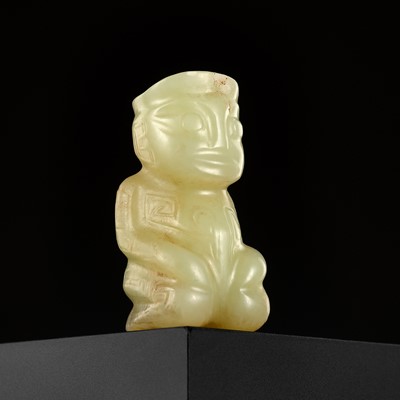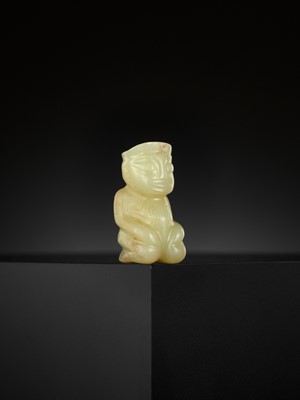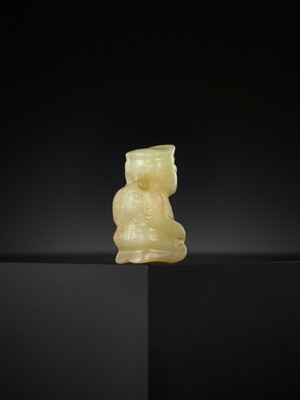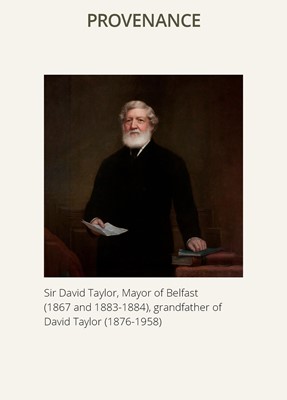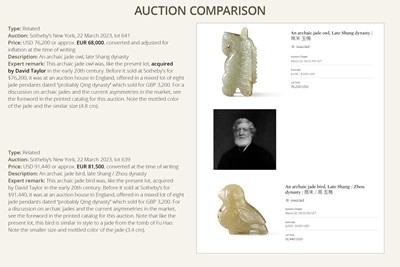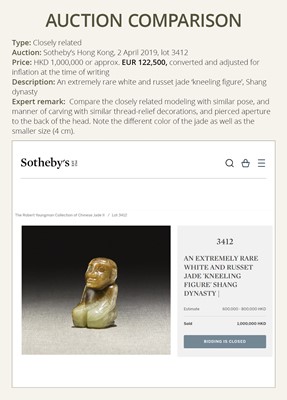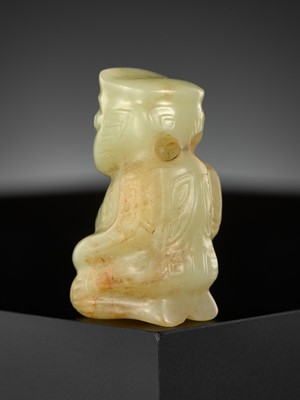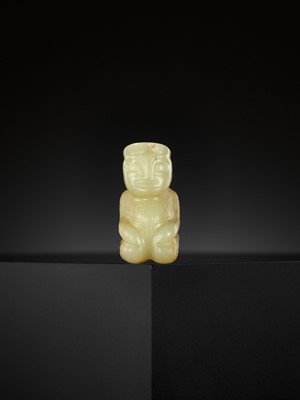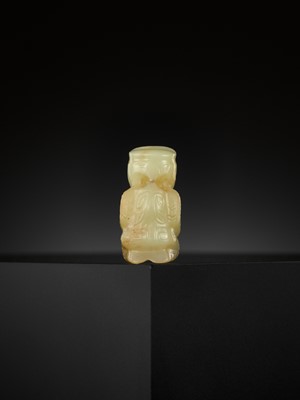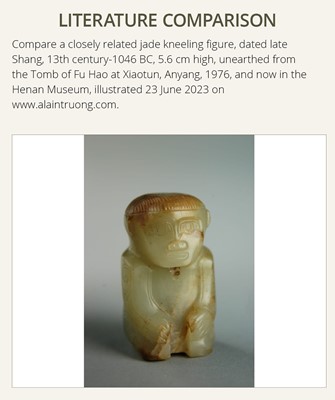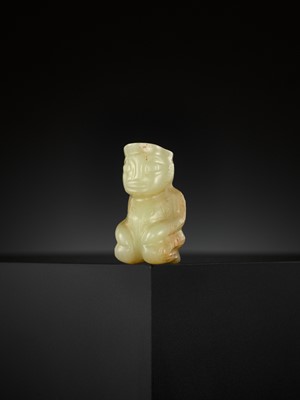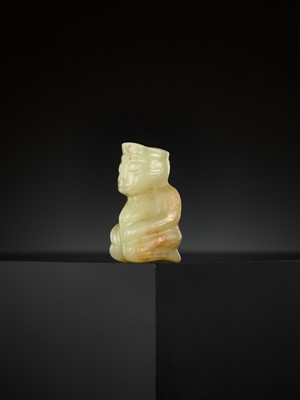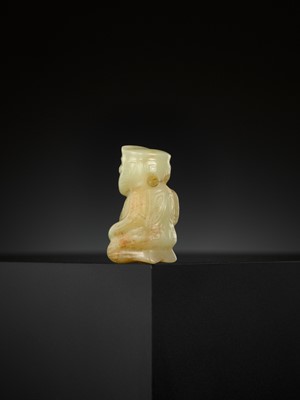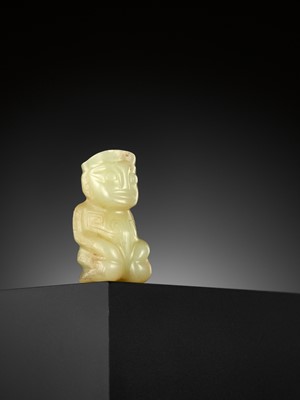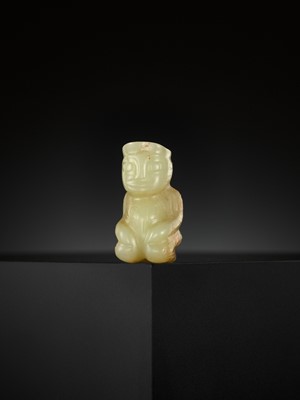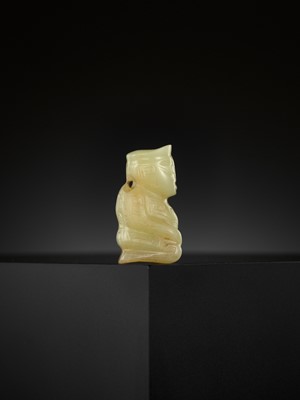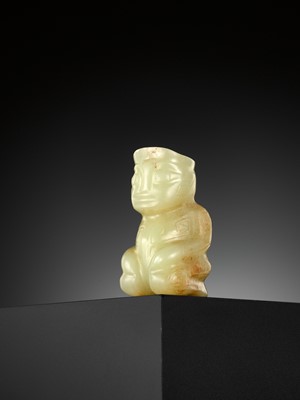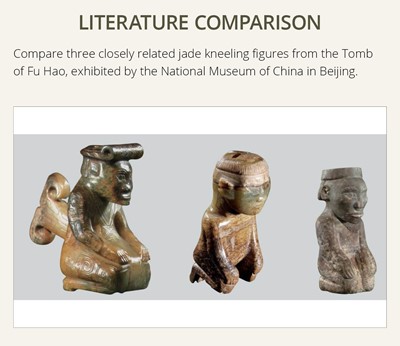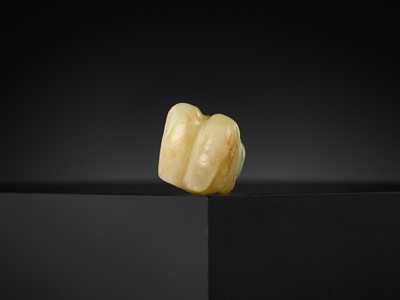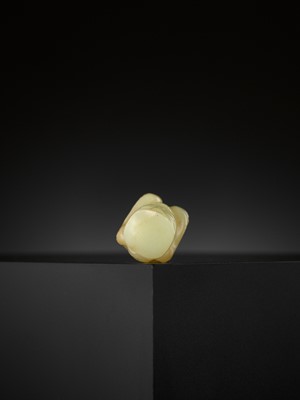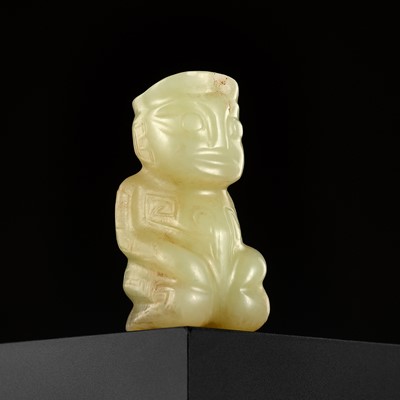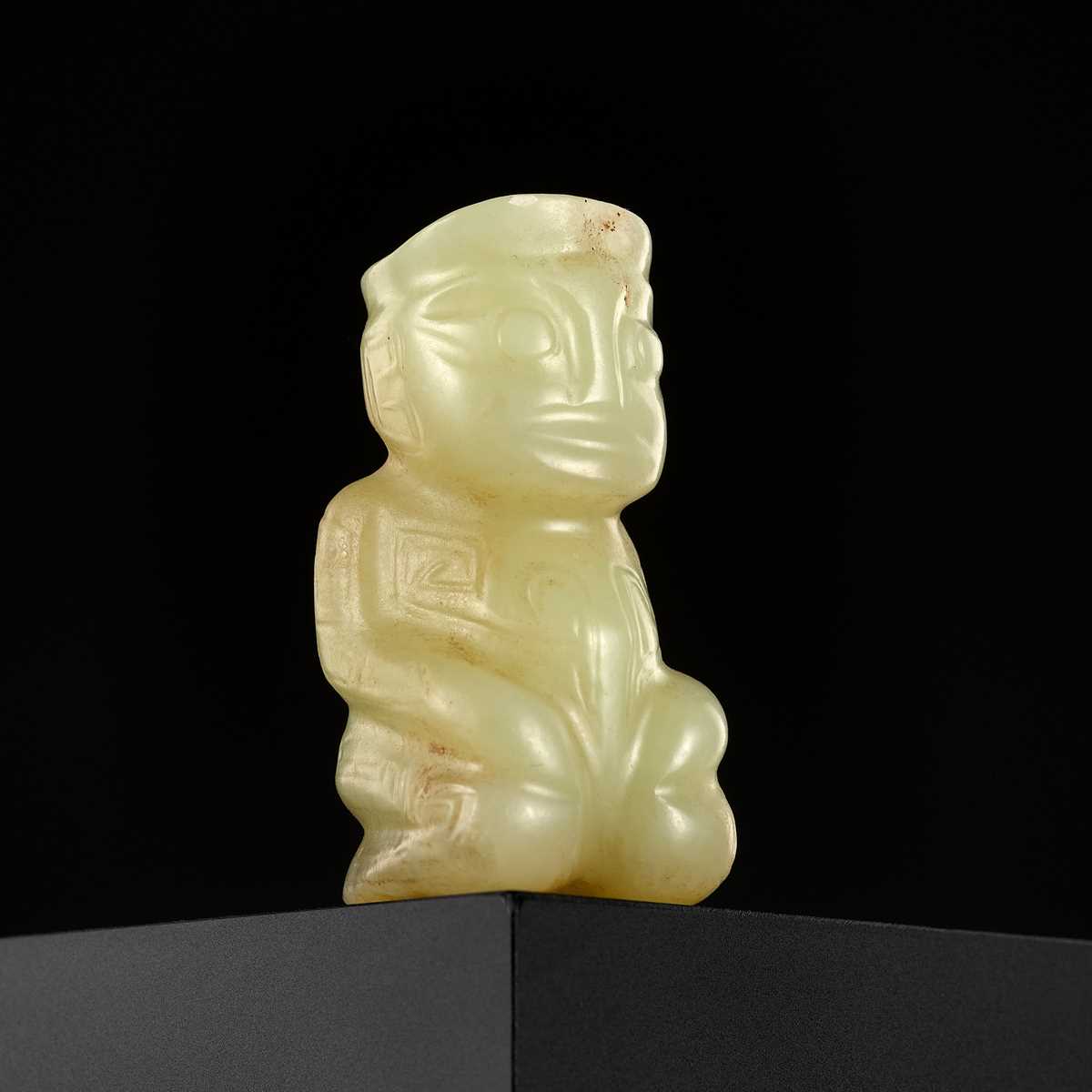1st Mar, 2024 10:00
The No Reserve Dragon Sale
48
AN EXTREMELY RARE YELLOW JADE ‘KNEELING FIGURE’, SHANG DYNASTY
商代罕見黃玉人俑
Sold for €31,200
including Buyer's Premium
Please note this Lot is to be sold at No Reserve. 本拍品不設底價
China, c. 1200 BC. Exquisitely carved, depicted with the head facing forward, the figure rendered kneeling with the body upright and the hands resting on the knees, portrayed with large eyes, a broad nose, and full lips, flanked by ears subtly detailed in thread relief, the chest, back, arms, and thighs similarly decorated with scrolling motifs. The back of the head pierced with an aperture. Translucent stone of a fine yellow tone with russet patches and veins.
Provenance: From the collection of David Taylor, and thence by descent within the Taylor family. David Taylor (1876-1958) was a notable British businessman who lived in Belfast and owned various commercial buildings along with a substantial portfolio of stocks and shares. During his travels to China in the early 20th century, he acquired many jades, including the present lot. His grandfather, Sir David Taylor, was born in 1815 in Perth, Scotland, and moved to Belfast in 1842, serving as its mayor in 1867 and for two consecutive terms in 1883 and 1884.
Condition: Superb condition, commensurate with age. Ancient wear, signs of weathering and erosion, few tiny nibbles, natural fissures and inclusions, one side with russet-colored encrustations. Overall presenting exceptionally well, with distinctive signs of age and burial, further adding to its remarkable appearance.
Weight: 49.5 g
Dimensions: Height 4.6 cm
Please click here to read the full description
Kneeling figures of this type are among the rarest jade artifacts from the Shang dynasty. Examples carved with related features have been found at the tomb of Lady Hao, dated to around 1200 BC, suggesting that this piece was made at around the same time. While the identification and function of these kneeling figures is a matter of speculation, their rarity suggests that “they are likely to have been extremely valuable and to have offered Fu Hao some sort of power or access to power” (see Jessica Rawson, Mysteries of Ancient China, London, 1996, page 108).
About a kneeling jade figure from the Tomb of Fu Hao, Ai Weiwei notes that “Some people believe this small carving represents Fu Hao herself, but I believe it’s more mythological than memorial in function — a ritual object related to a higher power” (see Ai Weiwei on a Shang Dynasty jade from the tomb of Fu Hao, published in 'It Speaks to Me: Art That Inspires Artists', 2019).
The Tomb of Fu Hao is an archaeological site at Yinxu, the ruins of the ancient Shang dynasty capital Yin, within the modern city of Anyang in Henan Province, China. Discovered in 1976 by Zheng Zhenxiang, it was identified as the final resting place of the queen and military general Fu Hao, who died about 1200 BC. She was likely to have been the Lady Hao inscribed on oracle bones by king Wu Ding as well as one of his many wives. The artifacts unearthed within the grave included 755 jade objects, among them besides contemporary Shang jades also Longshan, Liangzhu, Hongshan, and Shijiahe jades. It is to date the only Shang royal tomb found intact with its contents and excavated by archaeologists, never having been looted probably due its considerable distance from other known tombs.
Literature comparison:
Compare a closely related jade kneeling figure, dated late Shang, 13th century-1046 BC, 5.6 cm high, unearthed from the Tomb of Fu Hao at Xiaotun, Anyang, 1976, and now in the Henan Museum, illustrated 23 June 2023 on www.alaintruong.com. Compare three closely related jade kneeling figures from the Tomb of Fu Hao, exhibited by the National Museum of China in Beijing. Five kneeling figures from the tomb of Fu Hao are illustrated in 'Tomb of Fu Hao at Yinxu in Anyang', Beijing, 1980, pls. 129 and 130, together with two related jade heads, pl. 131, nos. 1 and 2. Compare a related jade kneeling figure, 4.3 cm high, dated 12th-11th century BC, in the collection of the Harvard Art Museums, object number 1943.50.317, included in the exhibition Ancient Chinese Jades, Fogg Art Museum, Harvard University, Cambridge, 1975, cat. no. 121. Compare a related jade kneeling figure from the collection of Jay C. Leff at Sotheby’s New York, 25 October 1975, lot 98. Compare a seated figure with knees raised, illustrated in 'Teng Shu P’ing, One Hundred Jades from the Lantien Shanfang collection', Taipei, 1995, pl. 37, together with a jade head, pl. 36.
Auction result comparison:
Type: Closely related
Auction: Sotheby’s Hong Kong, 2 April 2019, lot 3412
Price: HKD 1,000,000 or approx. EUR 122,500, converted and adjusted for inflation at the time of writing
Description: An extremely rare white and russet jade ‘kneeling figure’, Shang dynasty
Expert remark: Compare the closely related modeling with similar pose, and manner of carving with similar thread-relief decorations, and pierced aperture to the back of the head. Note the different color of the jade as well as the smaller size (4 cm).
Auction result comparison:
Type: Related
Auction: Sotheby’s New York, 22 March 2023, lot 639
Price: USD 91,440 or approx. EUR 81,500, converted at the time of writing
Description: An archaic jade bird, late Shang / Zhou dynasty
Expert remark: This archaic jade bird was, like the present lot, acquired by David Taylor in the early 20th century. Before it sold at Sotheby’s for $91,440, it was at an auction house in England, offered in a mixed lot of eight jade pendants dated “probably Qing dynasty” which sold for GBP 3,200. For a discussion on archaic jades and the current asymmetries in the market, see the foreword in the printed catalog for this auction. Note that like the present lot, this bird is similar in style to a jade from the tomb of Fu Hao. Note the smaller size and mottled color of the jade (3.4 cm).
Auction result comparison:
Type: Related
Auction: Sotheby’s New York, 22 March 2023, lot 641
Price: USD 76,200 or approx. EUR 68,000, converted and adjusted for inflation at the time of writing
Description: An archaic jade owl, late Shang dynasty
Expert remark: This archaic jade owl was, like the present lot, acquired by David Taylor in the early 20th century. Before it sold at Sotheby’s for $76,200, it was at an auction house in England, offered in a mixed lot of eight jade pendants dated “probably Qing dynasty” which sold for GBP 3,200. For a discussion on archaic jades and the current asymmetries in the market, see the foreword in the printed catalog for this auction. Note the mottled color of the jade and the similar size (4.8 cm).
点此阅读中文翻译 (Chinese Translation)
商代罕見黃玉人俑
中國,公元前約1200年。雕工精美,人俑頭朝前方平視,成跪姿,上身筆直,雙手擱膝,大眼、寬鼻、豐唇,兩側雙耳飾有細緻的螺紋浮雕,胸部、背部、手臂和大腿同樣飾有圖案。後腦勺穿孔。半透明玉石,呈細膩的黃色,帶有黃褐色斑紋。
來源:David Taylor收藏,一直保存在Taylor家族中。David Taylor (1876-1958) 曾是一位著名的英國商人,住在貝爾法斯特,擁有各種商業建築以及大量股票和股份。二十世紀初,他到中國旅行時購買了許多玉器,包括現在的這件。他的祖父戴維·泰勒爵士 1815 年出生於蘇格蘭Perth,1842 年移居Belfast,1867 年擔任市長,1883 年和 1884 年連任。
品相:狀態極佳,磨損,有風化和侵蝕的跡象、一些微小的磕痕、天然裂縫和內沁,一側有黃褐色的結殼。具有明顯的年代和埋葬痕跡。
重量:49.5 克
尺寸:高 4.6 厘米
這種跪像是商代玉器中十分罕見。公元前 1200 年左右的婦好墓中曾發現了有相似的玉人,説明本拍品大約也是來自同一時期。雖然這些跪著人物的身份和功能尚待研究,但它們為婦好提供了某種權力或獲得權力的途徑”(參見Jessica Rawson,《Mysteries of Ancient China》,倫敦,1996 年,第 108 頁)。
關於婦好墓中的跪姿玉人,艾未未指出,“有些人認為這個小造像代表了婦好本人,但我認為它在功能上更多的是神話性而非紀念性——一種與更高權力祭祀物品”(參見艾未未的論婦好墓中的商代玉器文章,發表於《It Speaks to Me: Art That Inspires Artists》,2019年)。
婦好墓位於殷墟的一處考古遺址,殷墟是中國商朝後期王都遺址,位於現代河南省安陽市內。它於 1976 年由鄭振香發現,被確定為皇后和將軍婦好的最後安息之地,婦好死於約公元前 1200 年。她很可能就是武丁王甲骨上所記載的好夫人,也是他眾多的妻子之一。墓內出土玉器755件,其中除當代商代玉器外,還有龍山玉、良渚玉、紅山玉、石家河玉等。 這是迄今為止唯一一座被考古學家發掘的內容完好的商代皇家陵墓,可能是因為它與其他已知陵墓相距甚遠,因此從未被盜過。
文獻比較:
比較一件非常相近的西元十三世紀至1046年商末玉跪人俑,高5.6 厘米,1976年出土於安陽小屯村婦好墓,現藏於河南博物館,見2023年6月23日www.alaintruong.com。比較三件非常相近的玉跪人俑出土於婦好墓,曾展覽於北京故宮博物院。五件出土於婦好墓的玉跪人俑,見《安陽殷墟婦好墓》,北京,1980年,圖129和130,和兩件相近的玉像,頁131,圖1和2。比較一件相近的西元前十二至十一世紀玉跪人俑,高4.3 厘米,收藏於哈佛藝術博物館,館藏編號1943.50.317,展覽於《古代中國玉器》,哈佛藝術博物館,劍橋,1975年,圖錄編號121。比較一件相近的玉跪人俑,來自 Jay C. Leff收藏,售於紐約蘇富比,1975年10月25,lot 98。比較一件玉跪坐人俑,見鄧淑蘋,《藍田山房藏玉百選》,台北,1995年,圖37,和一件相近的玉人頭,圖36。
拍賣結果比較:
形制:非常相近
拍賣:香港蘇富比,2019年4月2日,lot 3412
價格:HKD 1,000,000(相當於今日EUR 122,500)
描述:商玉跪人
專家評論:比較非常相近的姿勢、雕刻方式、紋飾,後腦勺有穿孔。請注意不同的玉石顏色,以及尺寸較小 (4 厘米)。
拍賣結果比較:
形制:相近
拍賣:紐約蘇富比,2023年3月22日,lot 639
價格:USD 91,440(相當於今日EUR 81,500)
描述:商末 / 周玉鳥
專家評論:與本拍品一樣,這件古老的玉鳥是David Taylor在 20 世紀初獲得的。曾在英國的拍賣行出售,和其他8 枚“可能是清代”的玉吊墜一起出售,售價為3,200 英鎊;售於蘇富比,售價91,440 美元。有關古代玉器和當前市場不對稱的討論,請參閱本次拍賣印刷圖錄的前言。請注意,與本拍品一樣,此鳥造型與婦好墓玉佩相似。 請注意玉石的尺寸較小和顏色斑駁(3.4 厘米)。
拍賣結果比較:
形制:相近
拍賣:紐約蘇富比,2023年3月22日,lot 641
價格:USD 76,200(相當於今日EUR 68,000)
描述:商末玉鴞
專家評論:與本拍品一樣,這件古老的玉貓頭鷹是David Taylor在 20 世紀初獲得的。曾在英國的拍賣行出售,和其他8 枚“可能是清代”的玉吊墜一起出售,售價為3,200 英鎊;售於蘇富比,售價76,200美元。有關古代玉器和當前市場不對稱的討論,請參閱本次拍賣印刷圖錄的前言。請注意,與本拍品一樣,此鳥造型與婦好墓玉佩相似。 請注意玉石的顏色斑駁和相似的尺寸 (4.8 厘米)。
Please note this Lot is to be sold at No Reserve. 本拍品不設底價
China, c. 1200 BC. Exquisitely carved, depicted with the head facing forward, the figure rendered kneeling with the body upright and the hands resting on the knees, portrayed with large eyes, a broad nose, and full lips, flanked by ears subtly detailed in thread relief, the chest, back, arms, and thighs similarly decorated with scrolling motifs. The back of the head pierced with an aperture. Translucent stone of a fine yellow tone with russet patches and veins.
Provenance: From the collection of David Taylor, and thence by descent within the Taylor family. David Taylor (1876-1958) was a notable British businessman who lived in Belfast and owned various commercial buildings along with a substantial portfolio of stocks and shares. During his travels to China in the early 20th century, he acquired many jades, including the present lot. His grandfather, Sir David Taylor, was born in 1815 in Perth, Scotland, and moved to Belfast in 1842, serving as its mayor in 1867 and for two consecutive terms in 1883 and 1884.
Condition: Superb condition, commensurate with age. Ancient wear, signs of weathering and erosion, few tiny nibbles, natural fissures and inclusions, one side with russet-colored encrustations. Overall presenting exceptionally well, with distinctive signs of age and burial, further adding to its remarkable appearance.
Weight: 49.5 g
Dimensions: Height 4.6 cm
Please click here to read the full description
Kneeling figures of this type are among the rarest jade artifacts from the Shang dynasty. Examples carved with related features have been found at the tomb of Lady Hao, dated to around 1200 BC, suggesting that this piece was made at around the same time. While the identification and function of these kneeling figures is a matter of speculation, their rarity suggests that “they are likely to have been extremely valuable and to have offered Fu Hao some sort of power or access to power” (see Jessica Rawson, Mysteries of Ancient China, London, 1996, page 108).
About a kneeling jade figure from the Tomb of Fu Hao, Ai Weiwei notes that “Some people believe this small carving represents Fu Hao herself, but I believe it’s more mythological than memorial in function — a ritual object related to a higher power” (see Ai Weiwei on a Shang Dynasty jade from the tomb of Fu Hao, published in 'It Speaks to Me: Art That Inspires Artists', 2019).
The Tomb of Fu Hao is an archaeological site at Yinxu, the ruins of the ancient Shang dynasty capital Yin, within the modern city of Anyang in Henan Province, China. Discovered in 1976 by Zheng Zhenxiang, it was identified as the final resting place of the queen and military general Fu Hao, who died about 1200 BC. She was likely to have been the Lady Hao inscribed on oracle bones by king Wu Ding as well as one of his many wives. The artifacts unearthed within the grave included 755 jade objects, among them besides contemporary Shang jades also Longshan, Liangzhu, Hongshan, and Shijiahe jades. It is to date the only Shang royal tomb found intact with its contents and excavated by archaeologists, never having been looted probably due its considerable distance from other known tombs.
Literature comparison:
Compare a closely related jade kneeling figure, dated late Shang, 13th century-1046 BC, 5.6 cm high, unearthed from the Tomb of Fu Hao at Xiaotun, Anyang, 1976, and now in the Henan Museum, illustrated 23 June 2023 on www.alaintruong.com. Compare three closely related jade kneeling figures from the Tomb of Fu Hao, exhibited by the National Museum of China in Beijing. Five kneeling figures from the tomb of Fu Hao are illustrated in 'Tomb of Fu Hao at Yinxu in Anyang', Beijing, 1980, pls. 129 and 130, together with two related jade heads, pl. 131, nos. 1 and 2. Compare a related jade kneeling figure, 4.3 cm high, dated 12th-11th century BC, in the collection of the Harvard Art Museums, object number 1943.50.317, included in the exhibition Ancient Chinese Jades, Fogg Art Museum, Harvard University, Cambridge, 1975, cat. no. 121. Compare a related jade kneeling figure from the collection of Jay C. Leff at Sotheby’s New York, 25 October 1975, lot 98. Compare a seated figure with knees raised, illustrated in 'Teng Shu P’ing, One Hundred Jades from the Lantien Shanfang collection', Taipei, 1995, pl. 37, together with a jade head, pl. 36.
Auction result comparison:
Type: Closely related
Auction: Sotheby’s Hong Kong, 2 April 2019, lot 3412
Price: HKD 1,000,000 or approx. EUR 122,500, converted and adjusted for inflation at the time of writing
Description: An extremely rare white and russet jade ‘kneeling figure’, Shang dynasty
Expert remark: Compare the closely related modeling with similar pose, and manner of carving with similar thread-relief decorations, and pierced aperture to the back of the head. Note the different color of the jade as well as the smaller size (4 cm).
Auction result comparison:
Type: Related
Auction: Sotheby’s New York, 22 March 2023, lot 639
Price: USD 91,440 or approx. EUR 81,500, converted at the time of writing
Description: An archaic jade bird, late Shang / Zhou dynasty
Expert remark: This archaic jade bird was, like the present lot, acquired by David Taylor in the early 20th century. Before it sold at Sotheby’s for $91,440, it was at an auction house in England, offered in a mixed lot of eight jade pendants dated “probably Qing dynasty” which sold for GBP 3,200. For a discussion on archaic jades and the current asymmetries in the market, see the foreword in the printed catalog for this auction. Note that like the present lot, this bird is similar in style to a jade from the tomb of Fu Hao. Note the smaller size and mottled color of the jade (3.4 cm).
Auction result comparison:
Type: Related
Auction: Sotheby’s New York, 22 March 2023, lot 641
Price: USD 76,200 or approx. EUR 68,000, converted and adjusted for inflation at the time of writing
Description: An archaic jade owl, late Shang dynasty
Expert remark: This archaic jade owl was, like the present lot, acquired by David Taylor in the early 20th century. Before it sold at Sotheby’s for $76,200, it was at an auction house in England, offered in a mixed lot of eight jade pendants dated “probably Qing dynasty” which sold for GBP 3,200. For a discussion on archaic jades and the current asymmetries in the market, see the foreword in the printed catalog for this auction. Note the mottled color of the jade and the similar size (4.8 cm).
点此阅读中文翻译 (Chinese Translation)
商代罕見黃玉人俑
中國,公元前約1200年。雕工精美,人俑頭朝前方平視,成跪姿,上身筆直,雙手擱膝,大眼、寬鼻、豐唇,兩側雙耳飾有細緻的螺紋浮雕,胸部、背部、手臂和大腿同樣飾有圖案。後腦勺穿孔。半透明玉石,呈細膩的黃色,帶有黃褐色斑紋。
來源:David Taylor收藏,一直保存在Taylor家族中。David Taylor (1876-1958) 曾是一位著名的英國商人,住在貝爾法斯特,擁有各種商業建築以及大量股票和股份。二十世紀初,他到中國旅行時購買了許多玉器,包括現在的這件。他的祖父戴維·泰勒爵士 1815 年出生於蘇格蘭Perth,1842 年移居Belfast,1867 年擔任市長,1883 年和 1884 年連任。
品相:狀態極佳,磨損,有風化和侵蝕的跡象、一些微小的磕痕、天然裂縫和內沁,一側有黃褐色的結殼。具有明顯的年代和埋葬痕跡。
重量:49.5 克
尺寸:高 4.6 厘米
這種跪像是商代玉器中十分罕見。公元前 1200 年左右的婦好墓中曾發現了有相似的玉人,説明本拍品大約也是來自同一時期。雖然這些跪著人物的身份和功能尚待研究,但它們為婦好提供了某種權力或獲得權力的途徑”(參見Jessica Rawson,《Mysteries of Ancient China》,倫敦,1996 年,第 108 頁)。
關於婦好墓中的跪姿玉人,艾未未指出,“有些人認為這個小造像代表了婦好本人,但我認為它在功能上更多的是神話性而非紀念性——一種與更高權力祭祀物品”(參見艾未未的論婦好墓中的商代玉器文章,發表於《It Speaks to Me: Art That Inspires Artists》,2019年)。
婦好墓位於殷墟的一處考古遺址,殷墟是中國商朝後期王都遺址,位於現代河南省安陽市內。它於 1976 年由鄭振香發現,被確定為皇后和將軍婦好的最後安息之地,婦好死於約公元前 1200 年。她很可能就是武丁王甲骨上所記載的好夫人,也是他眾多的妻子之一。墓內出土玉器755件,其中除當代商代玉器外,還有龍山玉、良渚玉、紅山玉、石家河玉等。 這是迄今為止唯一一座被考古學家發掘的內容完好的商代皇家陵墓,可能是因為它與其他已知陵墓相距甚遠,因此從未被盜過。
文獻比較:
比較一件非常相近的西元十三世紀至1046年商末玉跪人俑,高5.6 厘米,1976年出土於安陽小屯村婦好墓,現藏於河南博物館,見2023年6月23日www.alaintruong.com。比較三件非常相近的玉跪人俑出土於婦好墓,曾展覽於北京故宮博物院。五件出土於婦好墓的玉跪人俑,見《安陽殷墟婦好墓》,北京,1980年,圖129和130,和兩件相近的玉像,頁131,圖1和2。比較一件相近的西元前十二至十一世紀玉跪人俑,高4.3 厘米,收藏於哈佛藝術博物館,館藏編號1943.50.317,展覽於《古代中國玉器》,哈佛藝術博物館,劍橋,1975年,圖錄編號121。比較一件相近的玉跪人俑,來自 Jay C. Leff收藏,售於紐約蘇富比,1975年10月25,lot 98。比較一件玉跪坐人俑,見鄧淑蘋,《藍田山房藏玉百選》,台北,1995年,圖37,和一件相近的玉人頭,圖36。
拍賣結果比較:
形制:非常相近
拍賣:香港蘇富比,2019年4月2日,lot 3412
價格:HKD 1,000,000(相當於今日EUR 122,500)
描述:商玉跪人
專家評論:比較非常相近的姿勢、雕刻方式、紋飾,後腦勺有穿孔。請注意不同的玉石顏色,以及尺寸較小 (4 厘米)。
拍賣結果比較:
形制:相近
拍賣:紐約蘇富比,2023年3月22日,lot 639
價格:USD 91,440(相當於今日EUR 81,500)
描述:商末 / 周玉鳥
專家評論:與本拍品一樣,這件古老的玉鳥是David Taylor在 20 世紀初獲得的。曾在英國的拍賣行出售,和其他8 枚“可能是清代”的玉吊墜一起出售,售價為3,200 英鎊;售於蘇富比,售價91,440 美元。有關古代玉器和當前市場不對稱的討論,請參閱本次拍賣印刷圖錄的前言。請注意,與本拍品一樣,此鳥造型與婦好墓玉佩相似。 請注意玉石的尺寸較小和顏色斑駁(3.4 厘米)。
拍賣結果比較:
形制:相近
拍賣:紐約蘇富比,2023年3月22日,lot 641
價格:USD 76,200(相當於今日EUR 68,000)
描述:商末玉鴞
專家評論:與本拍品一樣,這件古老的玉貓頭鷹是David Taylor在 20 世紀初獲得的。曾在英國的拍賣行出售,和其他8 枚“可能是清代”的玉吊墜一起出售,售價為3,200 英鎊;售於蘇富比,售價76,200美元。有關古代玉器和當前市場不對稱的討論,請參閱本次拍賣印刷圖錄的前言。請注意,與本拍品一樣,此鳥造型與婦好墓玉佩相似。 請注意玉石的顏色斑駁和相似的尺寸 (4.8 厘米)。
Zacke Live Online Bidding
Our online bidding platform makes it easier than ever to bid in our auctions! When you bid through our website, you can take advantage of our premium buyer's terms without incurring any additional online bidding surcharges.
To bid live online, you'll need to create an online account. Once your account is created and your identity is verified, you can register to bid in an auction up to 12 hours before the auction begins.
Intended Spend and Bid Limits
When you register to bid in an online auction, you will need to share your intended maximum spending budget for the auction. We will then review your intended spend and set a bid limit for you. Once you have pre-registered for a live online auction, you can see your intended spend and bid limit by going to 'Account Settings' and clicking on 'Live Bidding Registrations'.
Your bid limit will be the maximum amount you can bid during the auction. Your bid limit is for the hammer price and is not affected by the buyer’s premium and VAT. For example, if you have a bid limit of €1,000 and place two winning bids for €300 and €200, then you will only be able to bid €500 for the rest of the auction. If you try to place a bid that is higher than €500, you will not be able to do so.
Online Absentee and Telephone Bids
You can now leave absentee and telephone bids on our website!
Absentee Bidding
Once you've created an account and your identity is verified, you can leave your absentee bid directly on the lot page. We will contact you when your bids have been confirmed.
Telephone Bidding
Once you've created an account and your identity is verified, you can leave telephone bids online. We will contact you when your bids have been confirmed.
Classic Absentee and Telephone Bidding Form
You can still submit absentee and telephone bids by email or fax if you prefer. Simply fill out the Absentee Bidding/Telephone bidding form and return it to us by email at office@zacke.at or by fax at +43 (1) 532 04 52 20. You can download the PDF from our Upcoming Auctions page.
How-To Guides
How to Create Your Personal Zacke Account
How to Register to Bid on Zacke Live
How to Leave Absentee Bids Online
How to Leave Telephone Bids Online
中文版本的操作指南
创建新账号
注册Zacke Live在线直播竞拍(免平台费)
缺席投标和电话投标
Third-Party Bidding
We partner with best-in-class third-party partners to make it easy for you to bid online in the channel of your choice. Please note that if you bid with one of our third-party online partners, then there will be a live bidding surcharge on top of your final purchase price. You can find all of our fees here. Here's a full list of our third-party partners:
- 51 Bid Live
- EpaiLive
- ArtFoxLive
- Invaluable
- LiveAuctioneers
- the-saleroom
- lot-tissimo
- Drouot
Please note that we place different auctions on different platforms. For example, in general, we only place Chinese art auctions on 51 Bid Live.
Bidding in Person
You must register to bid in person and will be assigned a paddle at the auction. Please contact us at office@zacke.at or +43 (1) 532 04 52 for the latest local health and safety guidelines.
